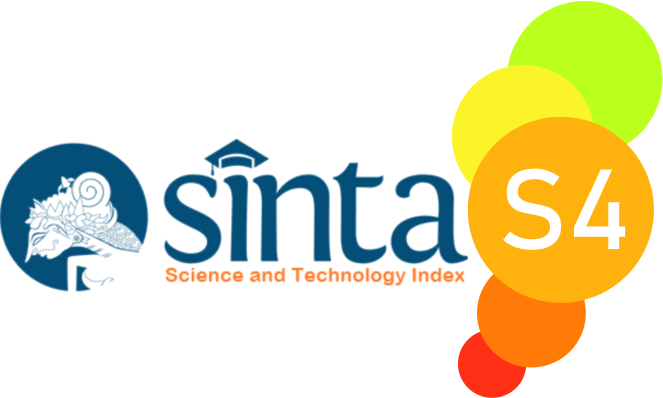Tiktok as a Learning Media in Teaching Speaking Skill: EFL Students’ Perception
Abstract
This study intended to investigate how students feel about utilizing TikTok as a learning tool to develop their speaking abilities. Social media is crucial to modern living, especially advancing education in the digital age. TikTok, one of the most popular social media platforms, is presently thought to be able to help students with their speaking abilities. The data from this research were statements from interview sessions conducted by five students in 11th grade at SMA Sejahtera Surabaya as a data source. The results obtained from this study were 3 different perceptions held by students. First, TikTok can be utilized as an extra learning tool because it offers a wide variety of information that allows students to master subjects that they don't understand in class. Second, TikTok may be utilized as an interactive learning tool since it offers engaging features that encourage students to actively participate in class. In addition, the duration of the video is quite short so that students don't get bored easily. Finally, TikTok can increase students' level of confidence in speaking English because TikTok provides various kinds of English-speaking exercises that can improve students' speaking skills and make them more confident.
References
Barrot, J. S. (2022). Social media as a language learning environment: A systematic review of the literature (2008-2019). Computer Assisted Language Learning, 35(9), 2534–2562. https://doi.org/10.1080/09588221.2021.1883673
Darvin, R. (2022). Design, resistance and the performance of identity on TikTok. Discourse, Context & Media, 46, 100591. https://doi.org/10.1016/j.dcm.2022.100591
Dewi, L. K., & Arifani, Y. (2021). The Utilization of Line Video Call and TikTok Video for Teaching Pronunciation in Thailand. Celtic: A Journal of Culture, English Language Teaching, Literature and Linguistics, 8(2). http://eprints.umg.ac.id/5591/
Escamilla-Fajardo, P., Alguacil, M., & López-Carril, S. (2021). Incorporating TikTok in higher education: Pedagogical perspectives from a corporal expression sport sciences course. Journal of Hospitality, Leisure, Sport & Tourism Education, 28, 100302. https://doi.org/10.1016/j.jhlste.2021.100302
Flick, U. (2009). An introduction to qualitative research (4th ed). Sage Publications.
Herlisya, D., & Wiratno, P. (2022). Having Good Speaking English through Tik Tok Application. Journal Corner of Education, Linguistics, and Literature, 1(3), 191–198. https://doi.org/10.54012/jcell.v1i3.35
Islam, R., & Musdalifah, M. (2022). Teaching Speaking Skill of English as Foreign Language in Secondary School Level. Journey: Journal of English Language and Pedagogy, 5(2). https://doi.org/10.33503/journey.v5i2.2083
John, E., & Yunus, M. M. (2021). A Systematic Review of Social Media Integration to Teach Speaking. Sustainability, 13(16), 9047. https://doi.org/10.3390/su13169047
Kaye, D. B. V., Chen, X., & Zeng, J. (2021). The co-evolution of two Chinese mobile short video apps: Parallel platformization of Douyin and TikTok. Mobile Media & Communication, 9(2), 229–253. https://doi.org/10.1177/2050157920952120
Maguire, M., & Delahunt, B. (2017). Doing a Thematic Analysis: A Practical, Step-by-Step Guide for Learning and Teaching Scholars. 8(3), 14.
Maulana, D., Wahyuni, W. S., & Siregar, D. (2019). THE CORRELATION BETWEEN MOTIVATION BEHAVIOUR AND SPEAKING ABILITY. PROJECT (Professional Journal of English Education), 1(2), 115. https://doi.org/10.22460/project.v1i2.p115-124
Novitasari, & Addinna, A. (2022). Students’ Perception on the Use of TikTok for Learning English. 11(4).
Pratiwi, A. E., Ufairah, N. N., & Sopiah, R. S. (2021). UTILIZING TIKTOK APPLICATION AS MEDIA FOR LEARNING ENGLISH PRONUNCIATION. 11.
Puspitasari, A. C. D. D. (2021). Aplikasi Tiktok Sebagai Media Pembelajaran Jarak Jauh Pada Mahasiswa Universitas Indraprasta PGRI. Jurnal Educatio FKIP UNMA, 7(3), 1127–1134. https://doi.org/10.31949/educatio.v7i3.1317
Schurz, A., Coumel, M., & Hüttner, J. (2022). Accuracy and Fluency Teaching and the Role of Extramural English: A Tale of Three Countries. Languages, 7(1), 35. https://doi.org/10.3390/languages7010035
Sheldrake, R. (2016). Confidence as motivational expressions of interest, utility, and other influences: Exploring under-confidence and over-confidence in science students at secondary school. International Journal of Educational Research, 76, 50–65. https://doi.org/10.1016/j.ijer.2015.12.001
Syamsiani, M., & Munfagati, R. (2023). Students’ Perception toward the Use of TikTok Videos for Learning English. Proceedings of International Conference On Language, Teaching, And Technology In Education (LATTE), 2, 324–329. https://doi.org/10.32528/issh.v2i1
Xiuwen, Z., & Razali, A. B. (2021). An Overview of the Utilization of TikTok to Improve Oral English Communication Competence among EFL Undergraduate Students. Universal Journal of Educational Research, 9(7), 1439–1451. https://doi.org/10.13189/ujer.2021.090710
Zainurrahman, & Sangaji, S. (2019). A Study on the University Students’ Speaking Difficulties. https://doi.org/10.5281/ZENODO.2588073
Zuhriyah, M. (2017). Storytelling to Improve Students’ Speaking Skill. English Education, 10(1), 16.
Copyright (c) 2023 Farisa Rahma Yulita, Hertiki Hertiki

This work is licensed under a Creative Commons Attribution-ShareAlike 4.0 International License.

Journey: Journal of English Language and Pedagogy by http://ejurnal.budiutomomalang.ac.id/index.php/journey/index is licensed under a Creative Commons Attribution-ShareAlike 4.0 International License.






